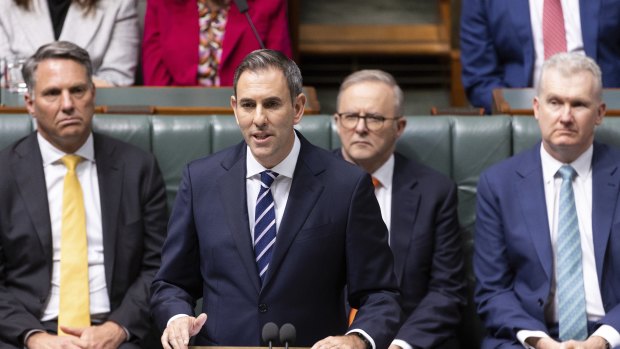This was published 6 months ago
Jim Chalmers to deliver first consecutive Labor budget surpluses since Paul Keating
By Shane Wright
Jim Chalmers will become the first Labor treasurer since Paul Keating in the 1980s to unveil a second consecutive budget surplus as the government attempts to talk up its economic credentials and efforts to bring down the cost of living.
Chalmers and Finance Minister Katy Gallagher will on Monday reveal a $15.8 billion surplus for the just completed 2023-24 budget. That follows a surplus of $22.1 billion in the 2022-23 budget.

Treasurer Jim Chalmers delivers the 2023-24 federal budget. At the time, he forecast a deficit of $13.9 billion.Credit: Alex Ellinghausen
The last time back-to-back budget surpluses were recorded was in 2006-07 and 2007-08 when John Howard was prime minister and Peter Costello was treasurer. The surpluses were worth a combined $36.9 billion compared to the $37.9 billion that Chalmers and Gallagher will confirm.
The result is a $29.7 billion improvement on the 2023-24 budget announced in May last year, and confirms Chalmers as the first Labor treasurer to deliver consecutive surpluses since Paul Keating did so in 1988-89 and 1989-90.
The result is a more than $6 billion improvement on what Chalmers forecast in May this year, with the better result due to a fall in total government spending. Total forecast revenue has also fallen since May.
Chalmers said the second consecutive surplus was proof of the government’s economic management credentials.
“These surpluses help pay down Liberal debt, help fight inflation and haven’t come at the expense of cost-of-living relief for people under pressure,” he said.
“We’re the first government to post back-to-back surpluses in nearly two decades. A second straight surplus is proof of our responsible economic management.”
The reduction in government spending should translate into a smaller deficit in the current financial year. Chalmers has forecast a deficit of $28.3 billion for 2024-25 with some of that due to an expected drop in prices for key commodities such as iron ore and LNG.
But the deficit is expected to grow, reaching $42.8 billion in 2025-26. If that forecast proves accurate, it would be among the 10 largest deficits on record.
The Coalition has ramped up attacks on the government, claiming extra government spending has contributed to the Reserve Bank’s increase in official interest rates since May 2022.
In May, Chalmers forecast total government spending in 2023-24 of $683 billion with that expected to increase to $726.7 billion in the current financial year. The single largest expense is forecast to be the GST at $91.6 billion, followed by the age pension ($58.9 billion), the NDIS ($42.9 billion) and aged care services ($32.3 billion).
Chalmers and Gallagher will also reveal total revenue will be lower than forecast in May when it was predicted to reach a record $692.3 billion. Of that, tax receipts were forecast to hit $638.8 billion or 23.8 per cent of GDP, the highest share of the economy since 2005-06.
Most of the slide in tax has been from companies as total employment has risen by more than 120,000 since the budget and wages growth has been around 4 per cent.
When the 2023-24 budget outcome was first forecast in 2020-21, then treasurer Josh Frydenberg tipped a deficit of $66.9 billion and that gross government debt would be at a record high of more than $1.1 trillion.
Chalmers will reveal gross debt at $906.9 billion, with a $4 billion saving in interest costs in 2023-24 and $80 billion over the coming decade. Since the start of the new financial year, however, gross debt has climbed and on Friday reached a record $933.1 billion. It is expected to stabilise around that level for the rest of the year.
The treasurer at the weekend returned from a trip to China, Australia’s largest trading partner, which is going through its most sustained economic slowdown this century.
Chalmers said that the price for iron ore was now at “quite low” levels, falling by 40 per cent since the start of the year, while prices for thermal coal had come down to a similar level.
He said this would have implications not just for the Australian economy but also for global activity.
Last week, the Reserve Bank used its six-monthly report into the financial system to note there were “imbalances” in China’s financial sector that were being exacerbated by its troubled real estate sector.
“A further loss of confidence – absent a timely and significant response from the Chinese authorities – could see stress spill over to the rest of the Chinese economy and financial system, which would likely affect Australia and the rest of the world through trade and risk-aversion channels,” it said.
Cut through the noise of federal politics with news, views and expert analysis. Subscribers can sign up to our weekly Inside Politics newsletter.